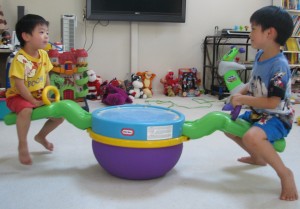When I saw this toy at Toy Fair, I was psyched. Little Tikes made a teeter toy years ago so I was happy to see it back in the line. I used to love teeter toys as a kid — it is a toy that involved having a good friend. Someone that would not give you too rough a ride, calm it down if it was going too fast (clearly you can see that I had issues). Rollercoasters were never my thing – a good teeter ball ride was as adventuresome as I got. Lame, probably–but just how I’m wired.
I sent a sample of the new Teeter Ball to one of our go to tester families…they have two boys, 6 and 3, and they like active play. Last year they were big on water/sand toys–not afraid of water, dirt, mud, etc. either– my kind of family!
While the boys enjoyed the toy, their dad gave the toy low marks when it came to putting it together. While he said you didn’t need a power drill, he had one and used it where screws were required. The most challenging part was “attaching the yellow ring and the inflatable purple ball.” He warned that this could pose a problem for people not comfortable putting things together. I’m certainly in that category. While I know that lots of people do have power drills and are far more handy than I am with putting things together, I really question from a consumer point of view why such effort and skill should be necessary for a toy. I appreciate the cost-cutting opportunity that at-home assembly provides, but I can’t imagine that such assembly engenders a great deal of good will. For $69 it seems to me the toy should either come good to go or without a huge amount of effort.
Our family also noted that the toy did not hold the boys interest for long stretches of time. I think that’s true of most teeter toys–they’re the type of toy you run to on the playground…take a turn and then go onto the next activity.
So be forewarned, almost all of the big plastic toys we have received this year required a power drill and a certain comfort zone in reading complicated directions (and making inferences from the picture on the box).
I was happy to read that the older brother waited for his little brother to get back on his seat when he fell off …that’s a very good sign that while the toy may not be a home run, these boys already have a lovely relationship.


